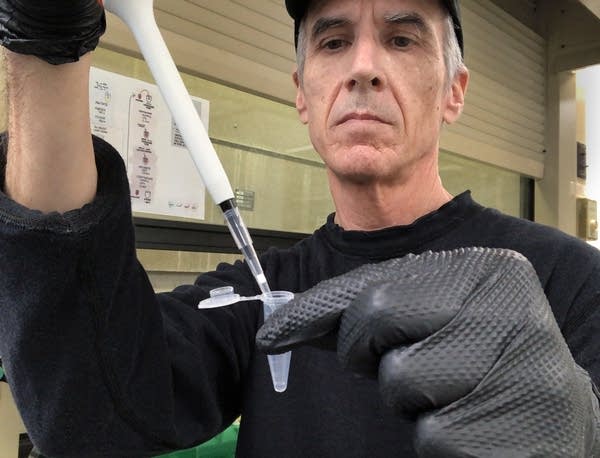Research: Scanning wastewater could offer advance warning of COVID — or other viruses

Go Deeper.
Create an account or log in to save stories.
Like this?
Thanks for liking this story! We have added it to a list of your favorite stories.
A year into the COVID-19 pandemic, Minnesota researchers say their effort to learn whether surveying a community’s sewage could help detect the prevalence of COVID-19 — and possibly predict surges of the virus — appears promising.
Last spring, Glenn Simmons Jr. and Richard Melvin, assistant professors at the University of Minnesota Medical School in Duluth, started regularly collecting samples of untreated wastewater from about 19 Minnesota cities.
They analyzed the samples for the genetic signature of SARS-CoV-2, the virus that causes COVID-19. Their goal was to see if they could spot evidence of the virus in wastewater before it started showing up in positive clinical tests, and maybe even anticipate the next hot spot.
"The penultimate objective was to determine if it was predictive, and then to see how predictive it could be,” Simmons said.
Turn Up Your Support
MPR News helps you turn down the noise and build shared understanding. Turn up your support for this public resource and keep trusted journalism accessible to all.
Previous studies have shown that people can be infected with the virus that causes COVID-19 and shed it in their feces well before they develop symptoms that might prompt them to seek a test.
Simmons said the data are still preliminary, and their preprint study has yet to be peer reviewed. It shows they were able to detect evidence of SARS CoV-2 in the wastewater of a place four to 20 days before people started testing positive at local clinics, depending on the region.
"Somewhere in the realm of 15 days ahead of time before whatever shows up in clinical cases, we're able to see that in the wastewater,” Simmons said.
That early warning sign of an outbreak has the potential to help public health officials decide where to direct testing and other health care resources.

Simmons and Melvin are now collecting wastewater samples twice a week from 44 communities of various sizes across Minnesota, and sharing the results with local officials. They plan to continue their work until at least September.
Eventually, Simmons said, the data could be shared publicly, so people can see where COVID-19 is on the rise, rather than relying on the lagging indicator of case numbers.
"Here we have something that's possibly a leading measure that could give us a lot more insight,” he said.
Widespread wastewater tracking
Wastewater surveillance has ramped up nationwide, with many cities and institutions doing similar research. The U.S. Centers for Disease Control and Prevention created a National Wastewater Surveillance System to collect data on COVID-19 in wastewater around the country.
Last spring, the Metropolitan Council, the agency that oversees housing, parks, transit and wastewater treatment for the seven-county Twin Cities metro area, began sending wastewater to the Duluth researchers and a Massachusetts lab.
But when COVID-19 cases surged in November, the Met Council’s environmental services staff decided to collect their own daily samples at the Metropolitan Wastewater Treatment Plant in St. Paul. The plant treats the wastewater of about 70 percent of the Twin Cities population, about 175 million gallons a day.
In a repurposed lab at the plant, scientists extract the genetic material or RNA of the SARS-CoV-2 virus from the wastewater. The frozen samples are then delivered to the University of Minnesota's Genomics Center in Minneapolis, where scientists measure the trace amounts of viral RNA.
So far, concentrations of the virus in wastewater have closely mirrored the changing infection rates in the Twin Cities, said Steve Balogh, principal research scientist in the Met Council’s environmental services division.
"Lo and behold, after a little while, we saw that we're actually tracking the case counts in the metro area here quite well,” he said.
Balogh said the research is a shift in approach for wastewater plants. Most plant operators treat wastewater to remove pathogens like viruses, he said, but don’t often consider how the sewage coming into the plant may reflect the health of the community.
Scanning wastewater, Balogh said, is a good way to be alert for problems on the horizon, including the possibility of new COVID-19 variants.
"When there doesn't appear to be a lot of disease in the community, well, maybe the wastewater epidemiology could be a signal that says, ‘Oh, you better watch out, it started to tick up here,’" Balogh said.
Simmons hopes that the tools they've developed can be used to monitor wastewater for other novel viruses and emerging pathogens in the future.
"It may be COVID-19 today. It could be chikungunya, or some version of a dengue virus or something people never think about here,” Simmons said. “But these are things that exist everywhere else in the world or in other places on the globe, and could possibly find themselves here one day."
COVID-19 in Minnesota
Data in these graphs are based on the Minnesota Department of Health's cumulative totals released at 11 a.m. daily. You can find more detailed statistics on COVID-19 at the Health Department website.
The coronavirus is transmitted through respiratory droplets, coughs and sneezes, similar to the way the flu can spread.


